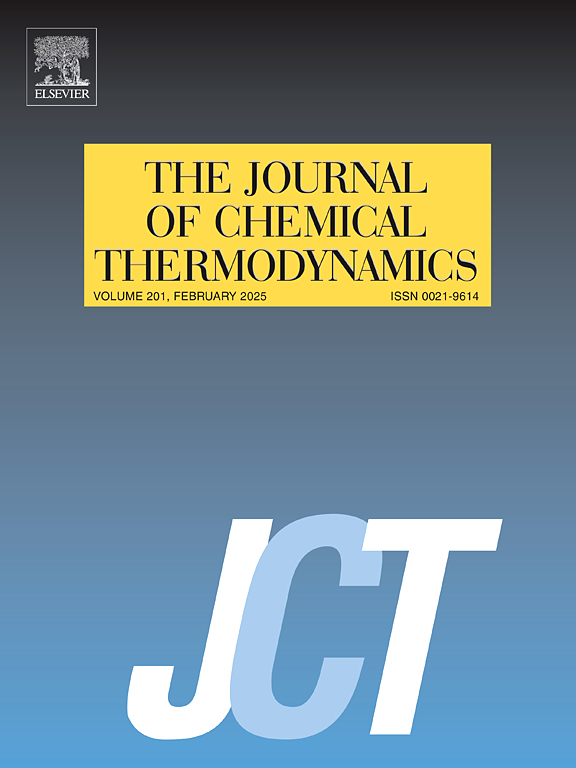Revealing the dissolution behavior of letrozole (form I) in four binary solvent systems: Solubility determination, thermodynamic analysis and molecular simulations
IF 2.2
3区 工程技术
Q3 CHEMISTRY, PHYSICAL
引用次数: 0
Abstract
Letrozole is a new aromatase inhibitor with extremely selective, which is widely used in the treatment of advanced postmenopausal breast cancer. This study focused on measuring the solubility of letrozole (form I) in four binary solvent systems (methanol + water, acetone + water, acetonitrile + water, methyl acetate + n-hexane) by the laser dynamic method at 0.1 MPa. The measured temperature ranged between 273.15 K and 323.15 K. It can be observed that when the composition of the binary solvents is constant, the solubility has a positive correlation with temperature. For methanol + water, acetone + water and methyl acetate + n-hexane binary solvent systems, a higher mass fraction of the positive solvent leads to an improvement in solubility. However, in the binary solvent system of acetonitrile + water, the co-solvency phenomena were detected. Five different models were applied to correlate the solubility data. The modified Apelblat equation demonstrated the most accurate fitting performance. The investigation of the Hirshfeld surface uncovered the intermolecular interactions in molecular crystals. For the sake of simulations, the electrostatic potentials (ESP) of the solvent and solute molecules were analyzed. The interactions between solute and solvent, as well as between the solvent and solvent, are crucial in determining the dissolution behavior, as demonstrated by the radial distribution function (RDF) analysis. The calculation of solvation free energy provides us a better insight into the dissolving characteristics of letrozole (form I). Furthermore, the apparent thermodynamic properties of the dissolution process of letrozole (form I) in four binary solvent systems were calculated, which indicates that the dissolution process is entropy-increasing and endothermic. Simple crystallization experiments were carried out, suggesting that acetone + water mixed solvent is the suitable solvent for letrozole anti-solvent crystallization. In summary, fundamental thermodynamic data for the design and optimization of the crystallization processes can be obtained from this study.
来曲唑(I型)在四种二元溶剂体系中的溶解行为:溶解度测定、热力学分析和分子模拟
来曲唑是一种具有极强选择性的新型芳香酶抑制剂,广泛应用于晚期绝经后乳腺癌的治疗。本文研究了在0.1 MPa下,用激光动力学方法测定来曲唑(形式I)在甲醇+水、丙酮+水、乙腈+水、乙酸甲酯+正己烷四种二元溶剂体系中的溶解度。测量温度在273.15 ~ 323.15 K之间。可以观察到,当二元溶剂的组成一定时,溶解度与温度呈正相关。对于甲醇+水、丙酮+水和乙酸甲酯+正己烷二元溶剂体系,正极溶剂的质量分数越高,溶解度越好。但在乙腈+水二元溶剂体系中,检测到共溶解现象。应用了五种不同的模型来关联溶解度数据。修正后的Apelblat方程具有最准确的拟合性能。对赫什菲尔德表面的研究揭示了分子晶体中的分子间相互作用。为了模拟,分析了溶剂和溶质分子的静电电位。径向分布函数(RDF)分析表明,溶质与溶剂之间以及溶剂与溶剂之间的相互作用是决定溶解行为的关键。溶剂化自由能的计算使我们更好地了解来曲唑(形式I)的溶解特性。计算了来曲唑(形式I)在4种二元溶剂体系中溶解过程的表观热力学性质,结果表明,来曲唑的溶解过程为增熵吸热过程。进行了简单结晶实验,表明丙酮+水混合溶剂是来曲唑抗溶剂结晶的合适溶剂。综上所述,可以从本研究中获得设计和优化结晶过程的基本热力学数据。
本文章由计算机程序翻译,如有差异,请以英文原文为准。
求助全文
约1分钟内获得全文
求助全文
来源期刊

Journal of Chemical Thermodynamics
工程技术-热力学
CiteScore
5.60
自引率
15.40%
发文量
199
审稿时长
79 days
期刊介绍:
The Journal of Chemical Thermodynamics exists primarily for dissemination of significant new knowledge in experimental equilibrium thermodynamics and transport properties of chemical systems. The defining attributes of The Journal are the quality and relevance of the papers published.
The Journal publishes work relating to gases, liquids, solids, polymers, mixtures, solutions and interfaces. Studies on systems with variability, such as biological or bio-based materials, gas hydrates, among others, will also be considered provided these are well characterized and reproducible where possible. Experimental methods should be described in sufficient detail to allow critical assessment of the accuracy claimed.
Authors are encouraged to provide physical or chemical interpretations of the results. Articles can contain modelling sections providing representations of data or molecular insights into the properties or transformations studied. Theoretical papers on chemical thermodynamics using molecular theory or modelling are also considered.
The Journal welcomes review articles in the field of chemical thermodynamics but prospective authors should first consult one of the Editors concerning the suitability of the proposed review.
Contributions of a routine nature or reporting on uncharacterised materials are not accepted.
 求助内容:
求助内容: 应助结果提醒方式:
应助结果提醒方式:


